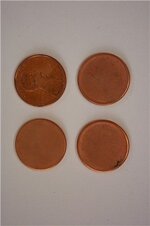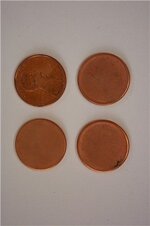C
Carl in CO
Guest
I found these slugs in a penny roll a few years back. I am wondering if anyone can tell me anything about them. They appear to be unstruck pennies. Their diameter is a fraction less than a penny. They appear to be the same width. They have more of a rounded corner. They don't have that sharp ridge that you feel when you run your thumb over the corner of a penny. This is my first post, so I hope the pic comes out ok. Some questions:
Are they unstruck pennies?
If so by what process did they get missed?
Do they have any value?
How would they be authenticated?
Where is the market for them?
Are they unstruck pennies?
If so by what process did they get missed?
Do they have any value?
How would they be authenticated?
Where is the market for them?




 duhhh Anyhow, we all know what "planchets" look like now.
duhhh Anyhow, we all know what "planchets" look like now. H.H.
H.H.
